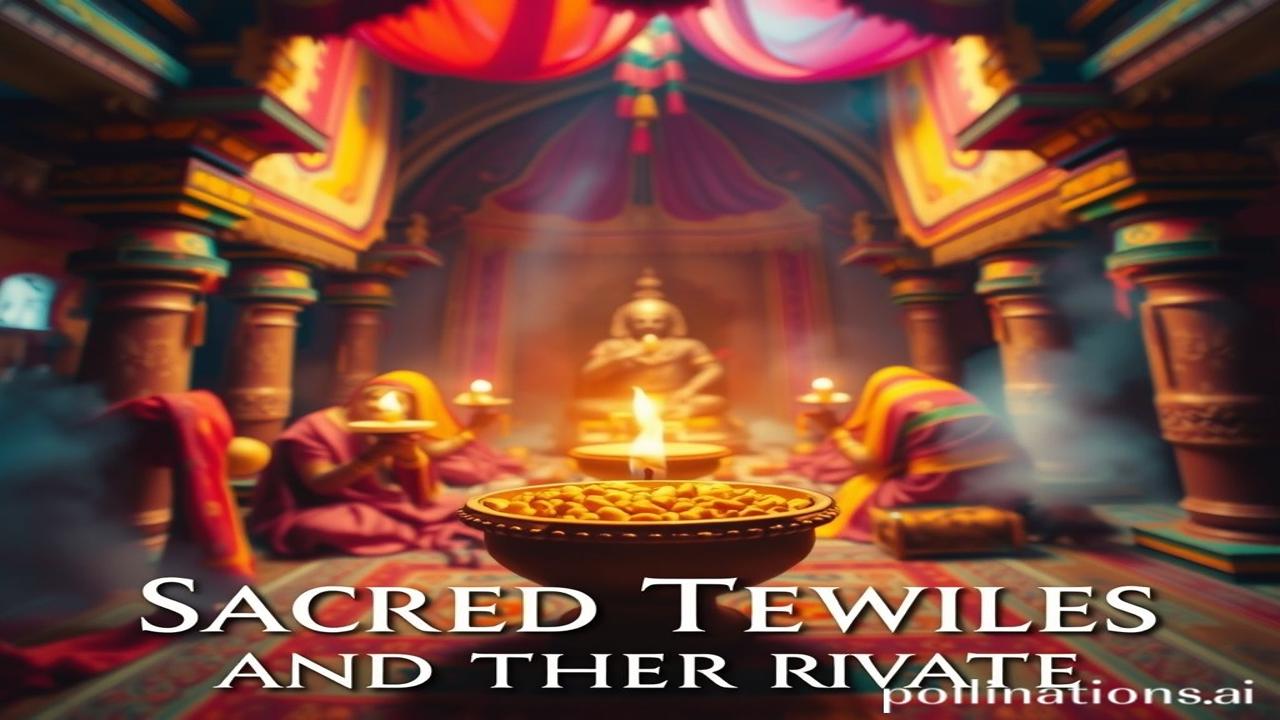Dhage Mein Bandhi Dharohar: Sacred Textiles and Their Rituals
Kabhi socha hai, jab mandir mein ghanti bajti hai, toh sirf aawaz nahi, ek puraana itihas bhi gunjta hai? Aur uss itihas mein, kapde, sirf kapde nahi, kahaniyan bhi hote hain. Stories woven into the very fabric of our being. Aaj hum baat karenge unhi sacred textiles aur unke rituals ki, jo humari sanskriti ka atoot hissa hain.
Itihas Ki Parat: The Tapestry of Time
Sacred textiles, yaane pavitra vastra, sirf jism dhakne ke liye nahi hote. Yeh Shakti ki nishaani hain, kala ka pradarshan, aur dharohar ka jivant roop. From the simple cotton robes of Buddhist monks to the elaborate silk sarees offered to goddesses, these textiles have played a vital role in religious ceremonies and spiritual practices across India for centuries.
Think about it – the origin stretches back to the Indus Valley Civilization (around 3300-1700 BCE), where fragments of cotton and linen have been found, suggesting a sophisticated understanding of textile production. Vedic texts, dating back to around 1500 BCE, mention elaborate garments and the ritualistic use of certain fabrics during yajnas (sacrifices). The Rigveda itself describes intricate weaving patterns and the symbolism associated with different colors.
These textiles weren’t just about aesthetics; they were believed to possess Shakti, a divine energy, capable of protecting, healing, and connecting the wearer to the divine.
Zameeni Sach: Loom, Life, and Legends
Imagine the scene: A weaver in Banaras, generations deep in her craft, meticulously creating a silk saree for a bride. The clack of the loom, a rhythmic pulse echoing through the narrow lanes. Each thread carefully chosen, each motif imbued with blessings and good wishes. Ma Rukmini ne aaj naye resham ke kapde pehne, kyunki aaj unki beti ka vivah hai. Her hands, stained with the vibrant dyes, move with a practiced grace, a legacy passed down from mother to daughter, generation after generation.
Or picture a Buddhist monk, clad in simple saffron robes, meditating peacefully in a remote monastery. The coarse fabric, dyed with natural pigments, represents his detachment from worldly possessions and his commitment to spiritual pursuits. His attire, a visual manifestation of his beliefs.
These textiles are interwoven with the lives of saints, rulers, artisans, and ordinary people alike. They are worn during festivals, offered as prayers, and used to adorn deities. They represent not just skill and craftsmanship, but also faith, devotion, and community.
Dharohar Aur Pehchan: Echoes of the Past in the Present
Even today, the tradition of using sacred textiles in rituals continues to thrive. From the pitambara (yellow silk cloth) offered to Lord Vishnu to the chunri (red scarf) draped over Durga Maa, these textiles remain an integral part of our religious practices. We see their presence in the vibrant colors and intricate designs adorning temples, in the sacred threads tied around wrists during festivals, and in the heirloom sarees passed down through families, each a repository of memories and blessings.
These textiles are more than just cloth; they are threads connecting us to our ancestors, to our beliefs, and to our cultural identity – Bharatiyata. They remind us of the importance of tradition, of craftsmanship, and of the power of faith.
Mazedar Tathya Ya Bhram-Bhanjak: Myth vs. Reality
Log samajhte hain ki sacred textiles sirf mandiron mein istemal hote hain, lekin asli sach yeh hai ki yeh har ghar, har parivar ka hissa hain. Think about the raksha bandhan thread, the tilak cloth, or the simple gamcha used for prayers. These are all sacred textiles in their own right, imbued with their own unique significance.
Another misconception is that only expensive silk or cotton can be considered sacred. In reality, the intention behind the cloth, the craftsmanship involved, and the context in which it is used are far more important than the material itself.
Drishya Aur Bhavnayein: A Sensory Tapestry
Imagine walking into a temple, the air thick with the scent of incense and sandalwood. The cool stone floor beneath your feet, the soft murmur of prayers echoing through the halls. Your eyes are drawn to the vibrant colors of the deity’s attire, the shimmering silk catching the light. The touch of the sacred thread on your wrist, a tangible connection to the divine.
The feeling of reverence, of peace, washes over you. You are surrounded by tradition, by faith, by the collective energy of generations of worshippers. This is the power of sacred textiles: to transport us to another world, to connect us to something larger than ourselves.
Antim Vichar Ya Uddharan: A Final Thread
In the intricate weaves of these sacred textiles, we find not just art and craftsmanship, but also a reflection of our collective soul. They remind us of the power of faith, the beauty of tradition, and the enduring strength of dharohar.
“Vastra keval aavran nahi, aatma ka pratik hai.” (Clothing is not just a covering, it is a symbol of the soul.)
